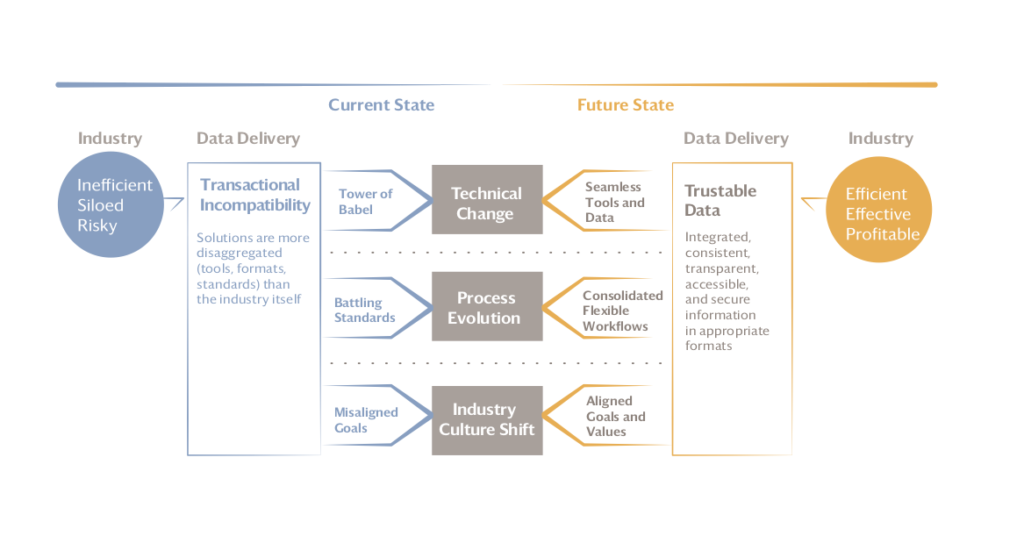Models, Analytics, Simulation

The building industry, while far behind others, is beginning to adopt the tools and strategies of the digital workplace. However, like the structure of the supply chain itself, information flows and data structures are sub-optimized to the particulars of a given task, role, or outcome. Architects work toward defining the abstract notion of “design intent,” or “how things should be when the contractor completes construction work;” contractors create vast piles of transactional information documenting the flows of money, time, and materials; subcontractors, plugged episodically into the contractors’ data stream, add shop drawings, bills of materials, and invoices; and finally, building owners sift through the resulting mountain of information to manage the resulting asset. What, if anything, might organize all this stuff, and how might that organizational strategy serve the noble goal of making ethical choices of slave-free materials?
Although largely used today for the generation and coordination of technical output called “working drawings,” at the center of these various and sundry data empires is the representation of the built artifact itself, the digital simulacrum that is a Building Information Model (BIM). More than just a three-dimensional representation of the building to be constructed, BIM is an underlying knowledge structure — an epistemological assertion — of how a building is organized, what elements comprise it, and how those elements are related. Each data object in the BIM represents the endpoint of a supply chain decision, and each can be a touchpoint from which an exploration and analysis of the origins of a selected element can be begun, and its relationship to a responsible supply chain established. And since a well-crafted BIM is the headwater of the design process, those data representations can be the anchor points of slave-free procurement that can persist from design, through construction, and into building operation.
Sophisticated representation, however robust through BIM, is necessary but not sufficient towards slave-free ends. If the design-to-construction digital model is the organizer from which to explore and resolve supply chain questions, the designer requires additional insight beyond a dynamic, three-dimensional, and potentially information- rich Digital Twin. The choice of a given material, product, or building system has immediate implications for a range of issues in the performance of the building. Today’s designers leverage BIM information for more proximate concerns like construction cost, energy usage, and code conformance through additional analytical engines that intelligently query and evaluate the simulated building. What if those more technical queries could be extended to questions of the ethical provenance — or lack thereof — of the architect’s or engineer’s decision?
Imagine the designer in the near future working within BIM on the design of a new project. As building systems, materials, or products are rendered into the digital representation of the design on her desktop computer, a parallel evaluation engine connected to an enormous “provenance” database might be running in the background. At appropriate intervals during the design, she might query a building component and be presented with a series of alternatives and specifications for designating the supplier of that element along with a description of a certified, slave-free supply sequence. Early in the design, this would eliminate choosing approaches dependent on unethical systems or components; later, it assists in proper detailed selection and specification. The resulting metadata could be encoded into the model for the reference (and continued validation) by the construction manager and its multi-tiered subs, suppliers, and manufacturers. The original BIM remains as the datum for such a system.
A similar system might, over time (and with machine- learned experience), monitor the development of a BIM-based design, analyzing the emergent construction for possible problems with eventual slave-related procurement. Much as today’s energy analysis engines can evaluate the preliminary resource demands of a building based only on a rough approximation of its shape, location, and use, an “ethical supply chain evaluator” could look at a similarly conceptual model and direct the designer away from certain strategies or materials that might be challenging to ethically obtain months or years down the road. The evaluation engines could be connected with software that models supply chain dynamics and pressure points, and query the architect’s or engineer’s model to flag issues.
These sorts of tools presage a time when the architect designs buildings with streams of data and insight brought forward into the decision-making process by information technology supplementing hard-fought experience. Models — geometric, analytical, process-based — can be the first set of armaments with which the building industry can fight the battle of responsible, ethical, and slave-free sourcing of materials and systems.